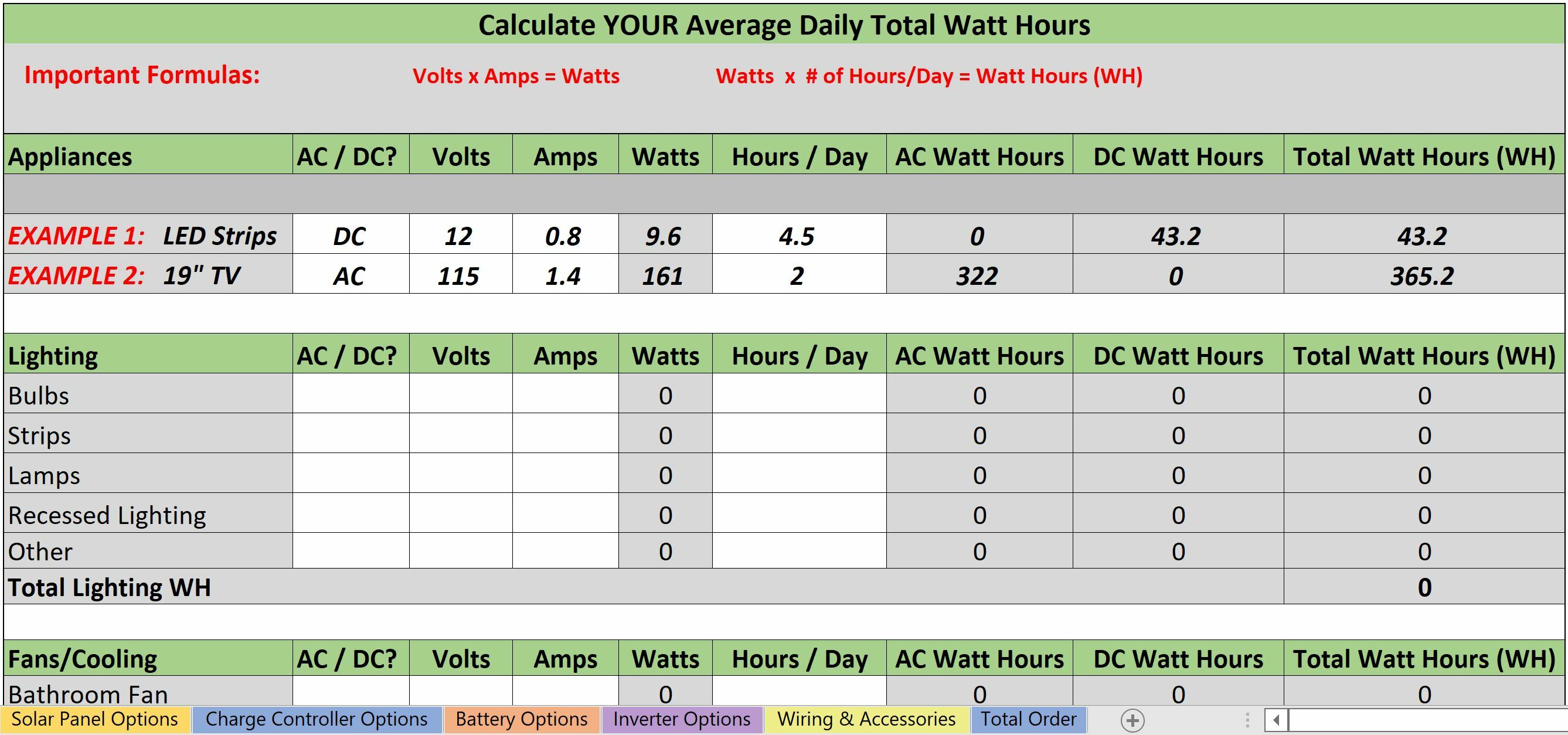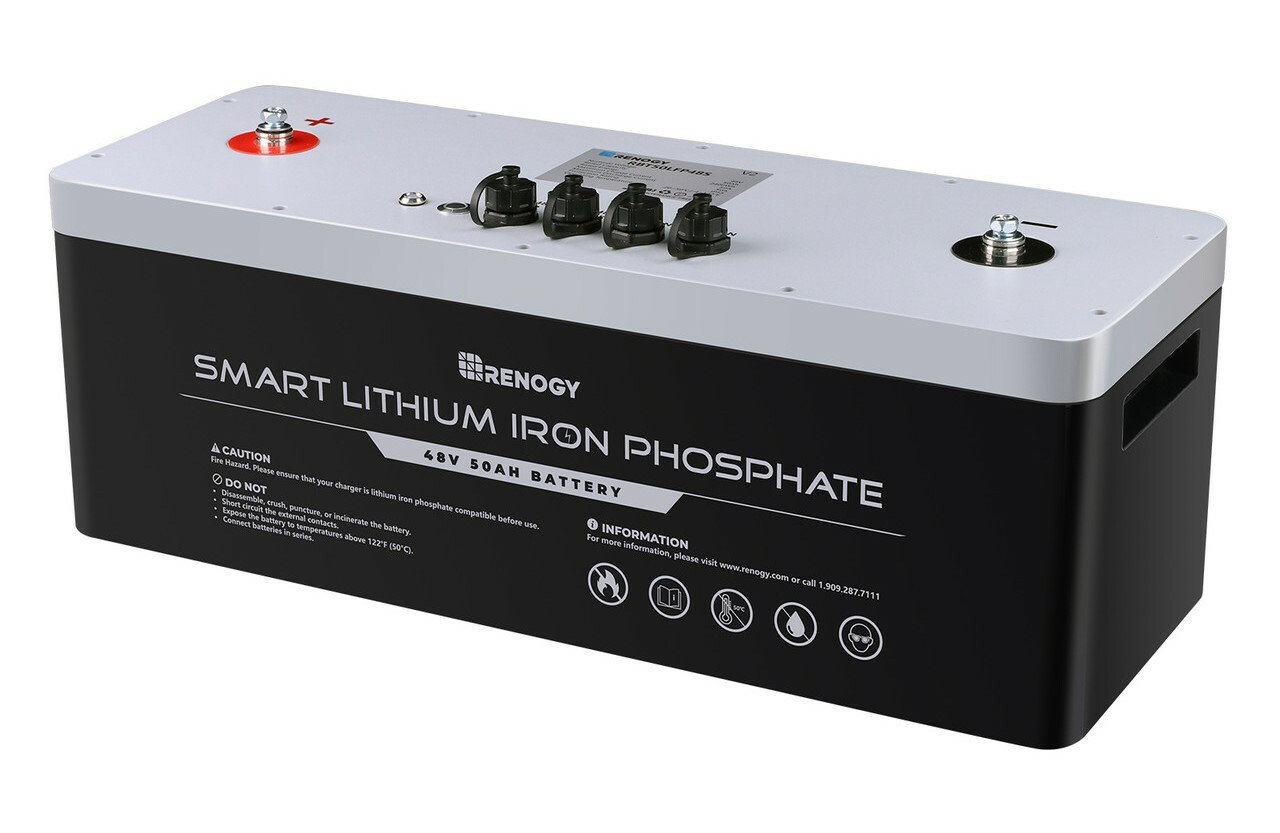Why Choose a 48V Battery Bank for Your Solar Powered System?
While most RVers can easily and inexpensively build a 12V solar panel and battery system that meets their basic DC and AC needs, folks with greater energy demands may find that a 24V system can help them run more powerful AC appliances. Going further, those who invest in a 48V system with enough solar panels and battery storage capacity, can even run electric heating and air conditioning more efficiently and at a lower cost installation!
Using a 12V system, running a heavy load means having more panels, larger capacity charge controllers, huge battery banks, and a lot of heavy duty wiring. Now, many solar consumers with higher energy demands are moving away from 12V and toward 24V or 48V systems for overall cost-space-benefit.
Looking at the basic Volts (V) x Amps (A) = Watts (W) equation, you can see how to achieve the same wattage by doubling the voltage of your overall system, thereby reducing the amperage by 50% at each step up in voltage.
For example, if we take a 1200W system and solve the equation for amps (A):
1200W / 12V battery = 100A
1200W / 24V battery = 50A
1200W / 48V battery = 25A
Each example provides the same amount of power (W), but by increasing the voltage we reduce the amperage. The resulting reduction of amperage means that we can use smaller, and less expensive cabling to deliver the same power. This chart provides a great example.

Looking at this chart, we can see that an electrical load of 100A for 15ft (4.6 Meters)in a “critical” circuit (voltage drop of less than 3%), the circuit needs a wire size of 2 AWG (35 metric). At 50A going the same distance, the circuit needs a wire size of 6 AWG (16 Metric), and at 25A, you can save a significant amount of money with 8 AWG (10 Metric). For those new to wire sizing, the AWG scale is not necessarily intuitive. The higher the number, the smaller the wire; and the smaller the wire, the less the cost per linear length.
Sizing your wires and fuses appropriately for the amperage they carry means that you are less likely to overload a wire which could cause a fire, burn out a fuse, trip a breaker, or damage an electrical appliance.
In this example, you can see how higher
voltage systems are not only safer, they are more cost effective, more efficient, weigh less, can be easier to build, and experience less transmission loss.
The first step in planning any off-grid solar system is to calculate your daily Total Watt Hours. This is the average daily power (measured in Watt Hours) you will consume through electrical appliances; we like to call it your “Magic Number.” Our Solar 101 video will explain in greater detail and our Solar System Sizing Worksheet will walk you through it step-by-step. Once you’ve calculated your Magic Number, you can begin to size your system accordingly.

Which Voltage is Best for My Solar Powered System?
For the most cost-space-benefit, here's a good rule of thumb that engineers use to determine the best voltage configuration for your system.
If your solar array capacity is:
- < 1000W then 12V is Good
- > 1000W and < 2000W then 24V is Better
- > 2000W or more then 48V is Best
For more information about how to build a safe and powerful 48V system, check out this blog.
48V Battery Bank Solutions Using Series vs Parallel Connections
The easiest way to get started with 48V is to pick up a dedicated 48V battery. Renogy offers a
48V-50Ah Lithium Iron Phosphate (LFP) battery with self-heating function that is ready to install into any system. These powerful babies are on a wicked pre-order sale right now, so you might want to act soon! With a capacity of 1.92kWh each (at an 80% Depth of Discharge or DoD), these batteries can be connected in parallel (up to 8) for a maximum capacity of 15.3kWh at the same DoD. Additionally, the self-heating function is perfect if your battery bank is likely to be exposed to colder temperatures. If the battery core temperature drops below 41℉ (5℃) and the battery management system detects a charging current, the battery uses a small amount of its energy to warm itself to be sure that the battery will charge efficiently when the temps outside have dropped below freezing.

Another option is to connect four 12V batteries using a series connection to create a 48V battery bank.Let’s compare the energy capacity you can achieve using a series connection of lead acid batteries vs. a series connection of Lithium Iron Phosphate batteries. For those new to battery chemistry lingo, all lead acid batteries (flooded, Gel, and AGM) have a nominal voltage of 12V and a safe depth of discharge (DoD) of 50%. LFP (or LiFePo4) batteries have a higher nominal voltage range of 12.5-12.8V and a safe DoD of 80%.
Let’s do the math…
Using either 200Ah AGM or Gel batteries (both lead acid chemistry), let’s connect 4 x 12V-200Ah batteries in series to create a 48V-200Ah battery bank. Using a safe DoD of 50% for lead acid, this battery bank capacity provides 4.8kWh (or 4800WH) of energy and weighs in at 512 lbs.

Now, let’s compare that with Lithium Iron Phosphate battery chemistry. Until recently LFP batteries could only be connected in parallel. Good news! Renogy just released the first of its CORE batteries that can be connected in series – the 200Ah-12V Lithium Iron Phosphate CORE battery! Using a series configuration with 4 x 200Ah CORE LFP batteries, the total battery bank capacity is 8.2kWH (or 8200WH) at 80% DoD and weighs in at just under 190 lbs. A huge difference in both capacity and weight over lead acid! This is an ideal option for a large RV with numerous high wattage household appliances, or even an entire off-grid house system.
Learn more about parallel and series (or even series-parallel combo) battery connections here.
Meet the LYCAN 5000 Power Box!
To put the power of Renogy’s 48V-50Ah battery into greater perspective, let’s look at the LYCAN 5000 Power Box, which includes 2 of these powerful Lithium Iron Phosphate (LiFePo) batteries as well as a 48V-3500W Solar Inverter Charger(which is an inverter, battery charger, and charge controller all in one), as well as a BT-2 Module and Communication Hub for monitoring your system via your smartphone. This powerful all-in-one solar generator is specially designed to supply power during emergencies, power outages, or even to provide power for off-grid homes or RVs which remain set-up for a season. As a 48V system, with a 4.8kWh capacity and a 3500W pure sine wave AC output (7000W peak power), the LYCAN can deliver power to most home and outdoor appliances. With its all-in-one design, it makes installing a full scale, yet portable, solar power system a breeze. We gave the LYCAN a test drive back in early 2022 – see below for our results.
With 4.8kWh, this unit can easily power most heavy-duty home and outdoor appliances with a continuous power output of 3500W and an impressive peak power of up to 7000W. It offers a 20A AC output to run basic household appliances, as well as a 30A AC output for more heavy duty equipment or larger household appliances. If that’s not enough power for your total energy needs, the LYCAN can be easily expanded to up to 19.2kWh by adding up to 6 additional 48V-50Ah Smart Lithium Iron Phosphate Batteries, covering most any situation from short term power outages to full energy independence. It’s important to note that you will still be limited to a 3500W load even if you add more battery storage.
To test the 20A output, we plugged in several high wattage household appliances such as a coffee maker, blow dryer, electric kettle, toaster, microwave, instant pot, electric heater – all with no problems. We found that we were able to run 2 higher wattage appliances (e.g., toaster and coffee maker) at one time, but when we added a third high wattage appliance like a hair dryer, it tripped the breaker. Thus, the system worked as expected and as it is designed to do. Note: You would be able to run a toaster, coffee maker, TV/laptop, and lights as those appliances combined would come in under 20A (max output) and 3500W (max load). We also used the 20A output to run large power tools such as a table saw, shop vac, and compound miter saw – again, it worked great! This unit would make a great power source for an off-grid construction project.
To test the 30A output, we rolled the unit through the ice and snow out to Hutch’s parents’ travel trailer and used their 30A power cord to power the entire camper. We tested their higher wattage appliances such as the microwave, heater, electric skillet, and coffee maker, while also running any phantom power sources such as the fridge, LP gas detector, and clock on the stereo. We spent the better part of the day testing the unit and cleaning out their camper to get it ready for camping season. In doing so, we ran the handheld vacuum, made coffee, ran the heater, etc. For a final test of the peak power and circuit breaker functionality, we used the 20A output to power a blow dryer at 1500W, while also running two other high wattage appliances on the 30A. It ran for about 20-30 seconds, then tripped the breaker. This would overload any 30A output at a campground as well, so we were satisfied that it sustained a peak load, then tripped the circuit breakers as expected. At the end of the day, we even had 53% of the battery left. Impressive!
As more people go off-grid and still want to be able to power their lives as they would in a traditional dwelling, we believe 48V systems are the future of solar power. The safety, efficiency, and cost savings of Renogy battery products are leading the way to a more sustainable future.

In 2012, Shari Galiardi & David Hutchison left behind careers and a comfortable home in North Carolina to travel with the vintage camper trailer they lovingly restored, outfitted with solar, and named "Hamlet." What began as a short break from careers and responsibility quickly turned into a love affair with roadlife. They have parlayed their higher education backgrounds, desire for life-long learning, and thirst for adventure travel into writing, photography, video production, and public speaking gigs from coast to coast. Known to their friends as simply Shari & Hutch, you can learn more about their full-time, solar-powered adventures on their website at freedominacan.com. Or, follow them on Facebook, Instagram, and YouTube as “Freedom in a Can, LLC.” Note: All links contained within this blog contain affiliate links provided by Freedom in a Can.











